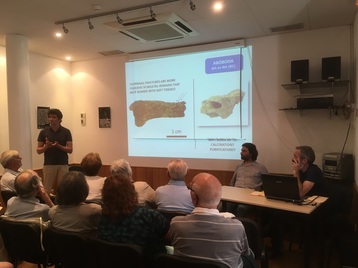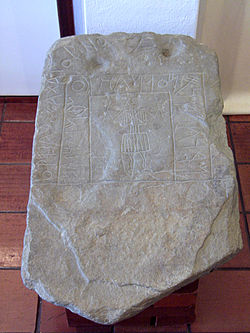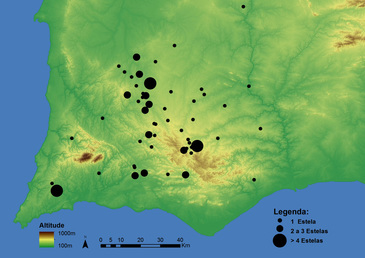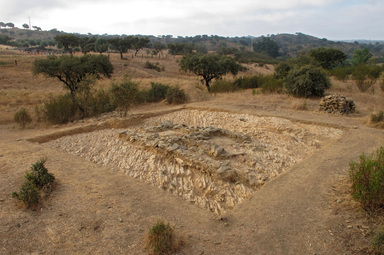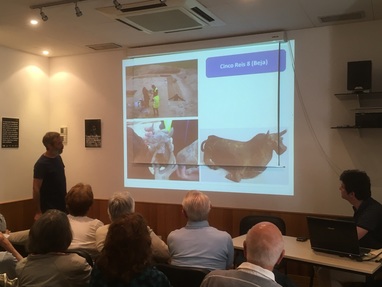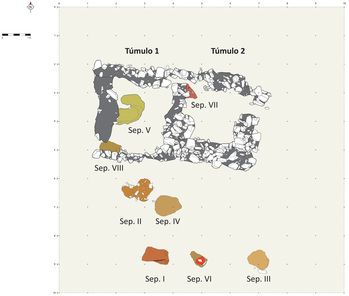2016 - May : Pedro Barros , Samuel Melro & David Gonçalves
New insights into the Iron age necropolises in southern Alentejo and Algarve
The contribution of the archaeologist Caetano Mello Beirão during the end of the 70’s and beginning of the 80’s of the 20th Century represented a crucial moment in the archaeological investigation of the Iron Age communities in the Alentejo and the Algarve.
|
Some of the models then conceived, however, have been altered in recent years. This occurred as result of new discoveries, new interpretations and new lines of investigation of the archaeological remains, including an interdisciplanary approach between archaeology and other sciences. Pedro Barros, Samuel Melro and David Gonzalves spoke about their work on a number of prehistoric sites in the Alentejo. |
Pedro gave an overview of their area of study and this was followed by David who has been looking at the human remains from the necropolises in particular. His studies include research into what effect cremation has on the human skeleton and to do this he is setting up a research collection at the University in Coimbra. The talk was concluded by Samuel Melro who explained that due to the extensive dam project in the Alentejo he and his team were able to identifiy new sites where their investigations were expanded prior to the flooding of the area. Included in the study of the necropolises the team have continued to search for and assimilate evidence of the Iberian script uniquely found in the Alentejo and Algarve.
|
The ESTELA Project was started in 2008 and aims the systematization of information about the stalae with South-Western (or sometimes also called Tartesian) Script. This is considered by linguistic researchers to be the oldest (and still not deciphered) written form of the Iberian Peninsula (and one of the oldest of Europe), little being known about the society and culture behind it.
|
Geographically set in an area in the South of Portugal, the main concentration of stelae seems to be located away from the direct influences of the Eastern Mediterranean cultural centres of the first millennium BC.
|
The ESTELA Project is aiming to reach better knowledge between the South-Western Script stelae and the world of the living (settlements); the "cities of the dead" (necropolises); and the SW Script evidences (stelae). The councils of Almodôvar and Loulé are the major participants in the ESTELA project and was additionally supported by the Archaeological Association of the Algarve (2012) and by the German Archaeological Institute. |
Samuel Melro and Pedro Barros, whose scientific research has involved the Iron Age in the South of Portugal, are the archaeologists responsible for the ESTELA project. They were joined by investigators from other disciplines.
Samuel Melro is an archaeologist of the Regional Directorate of Culture of the Alentejo and Castro Verde involved in the protection and management of the archaeological heritage. He is responsible for the monitoring of archaeological work in the context of the Alqueva Irrigation blocks and evaluation of the archaeological sites of Castelinho in Almodôvar.
Pedro Barros has worked since 1998 in the management of archaeological heritage in the Algarve, especially in its protection and research, but also in the dissemination and education of the heritage. Presently he is an archaeologist at the National Centre of Maritime Archaeology of the General Directorate of Cultural Heritage.
David Gonçalves is a bioarchaeologist interested in burial practices of the past, especially the cremation which was very popular among the people of the Iron Age. He is currently a post-doctoral fellow and coordinates the creation of the first worldwide collection of specified skeletons which were experimentally burned (HOT Project).
Samuel Melro is an archaeologist of the Regional Directorate of Culture of the Alentejo and Castro Verde involved in the protection and management of the archaeological heritage. He is responsible for the monitoring of archaeological work in the context of the Alqueva Irrigation blocks and evaluation of the archaeological sites of Castelinho in Almodôvar.
Pedro Barros has worked since 1998 in the management of archaeological heritage in the Algarve, especially in its protection and research, but also in the dissemination and education of the heritage. Presently he is an archaeologist at the National Centre of Maritime Archaeology of the General Directorate of Cultural Heritage.
David Gonçalves is a bioarchaeologist interested in burial practices of the past, especially the cremation which was very popular among the people of the Iron Age. He is currently a post-doctoral fellow and coordinates the creation of the first worldwide collection of specified skeletons which were experimentally burned (HOT Project).
